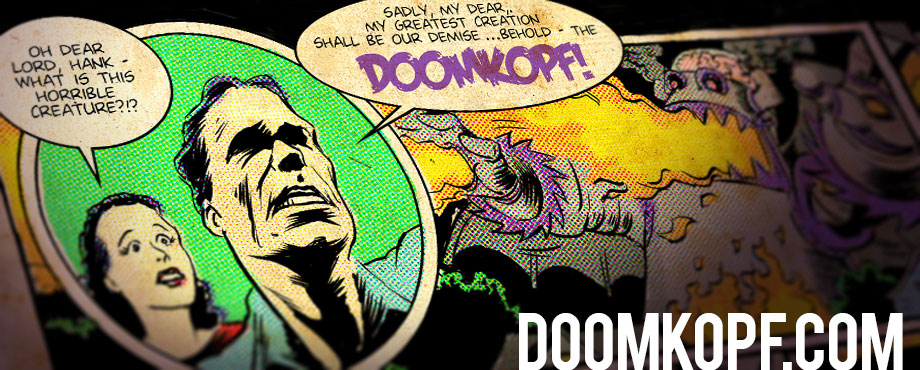Jack Kirby’s Fourth World Omnibus: Vol. 1
By Jack Kirby
Published by DC Comics, 2007. $49.99.
 The Plot: This all started in 1971. The King, Jack Kirby, co-creator of scores of famous characters at Marvel, jumps ship and moves over to DC, where he’s able to tell his stories his way. Only inker Vince Coletta shares any credit in the ensuing “Fourth World” event, a several years long epic tale of struggle between the good guys and Darkseid. Laid out in the issues of Jimmy Olsen, Mr. Miracle, the New Gods and other series, Kirby spun out a huge amount of content that all tied into this central battle. Relying only on Olsen and Superman as familiar characters, Kirby spun out a ream of new characters: the New Gods, Black Racer, the Forever People, etc. This first volume (three more are upcoming) brings the story to Darkseid’s imminent attack on earth, with the various heroes all clinging to slim hope.
The Plot: This all started in 1971. The King, Jack Kirby, co-creator of scores of famous characters at Marvel, jumps ship and moves over to DC, where he’s able to tell his stories his way. Only inker Vince Coletta shares any credit in the ensuing “Fourth World” event, a several years long epic tale of struggle between the good guys and Darkseid. Laid out in the issues of Jimmy Olsen, Mr. Miracle, the New Gods and other series, Kirby spun out a huge amount of content that all tied into this central battle. Relying only on Olsen and Superman as familiar characters, Kirby spun out a ream of new characters: the New Gods, Black Racer, the Forever People, etc. This first volume (three more are upcoming) brings the story to Darkseid’s imminent attack on earth, with the various heroes all clinging to slim hope.
The Positives: There seems to be a sort of standard knee-jerk reaction to either worship Kirby or despise him for being overrated. And while I probably lean toward that latter camp, there are certainly some worthwhile reasons for picking up this book. First, it’s always interesting to see the fruits of a freed imagination. As editor, writer and artist of these books, Kirby could do whatever he damn well pleased. And he really loosened up, throwing out some of the weirdest stuff in mainstream comics. The adventures of Mr. Miracle were more than just tales of escapes (and quite similar to those of the Escapist). They were forays into science and psychology. The interactions of Superman and inhabitants of the Wild Land served as commentary on the crash between hippies and the older, more stoic part of society. Kirby’s imagining of a cloning lab also rings surprisingly true.
As for his art, I liked it quite a lot. The layouts are impressive and (mostly) varied. His faces are easily distinguishable and emotive. Judging from his pencil sketches, I’d say Coletta’s inks did little to boost Kirby’s work. Lastly, there’s something impressive about Kirby taking on such a grandiose and massive project. The compilation reads quite smoothly and shows how well Kirby set up his project and organized it.
The Negatives: At the front of this volume, there’s an introduction by Grant Morrison in which he essentially calls Kirby the greatest thing since a wheel made of sliced bread. He goes on and on about Kirby’s wonderful imagination and ability to spin drama on the page. Understandably, Morrison doesn’t make the caveat that really needs to go along with Kirby’s work: The King’s dialogue is laughably bad, his creations are often silly, his plots are light as gossamer and all the humor is unintentional.
Of the 400-some pages in this Omnibus, you can flip open to pretty much any of them and come across something so ridiculous that you just have to shake your head and wonder if Kirby partook in some of Morrison’s extracurricular activities. The pinnacle of preposterousness is the “Black Racer,” quite predictably a black hero (or villain?) who glides through the air on snow skis (with the poles) and shoots energy. Seriously. A black dude on snow skis from outer space. Ummm… Right. He’s an obvious rip off of the Silver Surfer, and isn’t alone in that respect. A giant green clone of Jimmy Olsen battles Superman at one point. It looks just like, you guessed it, the Hulk.
Still, I don’t think anything tops the dialogue. The hippies speak in such stilted hippie-speak that I couldn’t help but giggle. Superman is a parody of himself. Darkseid comes across not as terrifying but delusioned and bumbling. The Newsboy Legion are a collection of annoying 1940s era youth, their dialogue seemingly pulled from poorly written movies of that era. It’s just a trainwreck, which is only made worse by the over-abundance of dialogue. It’s just the ultimate proof that even the most talented among us need an editor beyond themselves.
The Grade: C+ Granted, this book just isn’t for me. Anyone with romantic attachments to comics of the 1960s and 1970s will get a whole lot more out of it than I did. For me, the only real relevance was that DC is bringing back a lot of the Fourth World stuff in Countdown. But I really haven’t liked Countdown, so I guess that’s not a good thing either.
